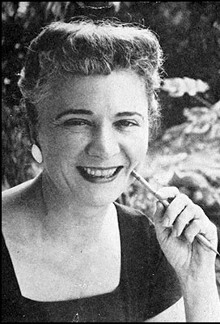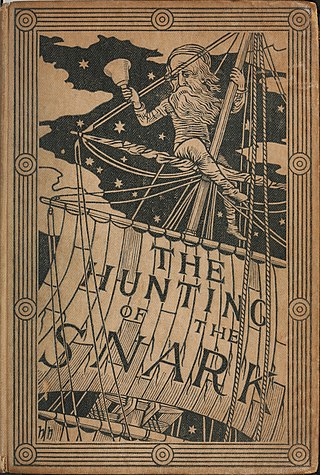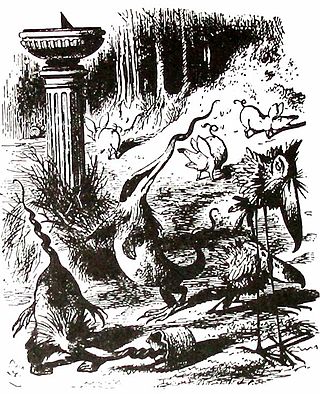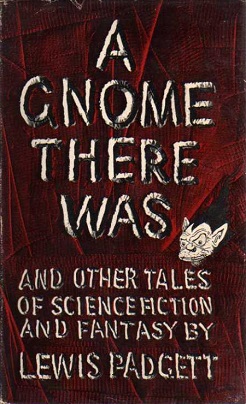Related Research Articles

Catherine Lucille Moore was an American science fiction and fantasy writer, who first came to prominence in the 1930s writing as C. L. Moore. She was among the first women to write in the science fiction and fantasy genres. Moore's work paved the way for many other female speculative fiction writers.

"Jabberwocky" is a nonsense poem written by Lewis Carroll about the killing of a creature named "the Jabberwock". It was included in his 1871 novel Through the Looking-Glass, the sequel to Alice's Adventures in Wonderland (1865). The book tells of Alice's adventures within the back-to-front world of the Looking-Glass world.

Through the Looking-Glass, and What Alice Found There is a novel published on 27 December 1871 by Lewis Carroll, a mathematics lecturer at Christ Church, University of Oxford, and the sequel to Alice's Adventures in Wonderland (1865). Alice again enters a fantastical world, this time by climbing through a mirror into the world that she can see beyond it. There she finds that, just like a reflection, everything is reversed, including logic.

The Hunting of the Snark, subtitled An Agony, in Eight fits, is a poem by the English writer Lewis Carroll. It is typically categorised as a nonsense poem. Written between 1874 and 1876, it borrows the setting, some creatures, and eight portmanteau words from Carroll's earlier poem "Jabberwocky" in his children's novel Through the Looking-Glass (1871).

Nonsense verse is a form of nonsense literature usually employing strong prosodic elements like rhythm and rhyme. It is often whimsical and humorous in tone and employs some of the techniques of nonsense literature.

Alice Pleasance Hargreaves was an English woman who, in her childhood, was an acquaintance and photography subject of Lewis Carroll. One of the stories he told her during a boating trip became the classic 1865 children's novel Alice's Adventures in Wonderland. She shared her name with "Alice", the story's heroine, but scholars disagree about the extent to which the character was based upon her.
Mark Clifton (1906–1963) was an American science fiction writer, the co-winner of the second Hugo Award for best novel. He began publishing in May 1952 with the widely anthologized story "What Have I Done?".
"Jabberwocky" is an 1872 nonsense poem by Lewis Carroll, about an encounter between a young boy and a monster called the Jabberwock.
Lewis Padgett was the joint pseudonym of the science fiction authors and spouses Henry Kuttner and C. L. Moore, taken from their mothers' maiden names. They also used the pseudonyms Lawrence O'Donnell and C. H. Liddell, as well as collaborating under their own names.
Roger Gilbert Lancelyn Green was a British biographer and children's writer. He was an Oxford academic who formed part of the Inklings literary discussion group along with C. S. Lewis and J. R. R. Tolkien. He had a positive influence on his friend, C.S. Lewis, by encouraging him to publish The Lion, the Witch and the Wardrobe.

Analog's Children of the Future is the third in a series of anthologies of science fiction stories drawn from Analog magazine and edited by then-current Analog editor Stanley Schmidt. It was first published in paperback by Davis Publications and hardcover by The Dial Press in December 1982.
— From Lewis Carroll's "Jabberwocky", published as part of Through the Looking Glass

The Last Mimzy is a 2007 American science fiction adventure drama film directed by New Line Cinema founder Robert Shaye. It was loosely based upon the 1943 science fiction short story "Mimsy Were the Borogoves" by Lewis Padgett. The film features Timothy Hutton, Joely Richardson, Rainn Wilson, Kathryn Hahn, Michael Clarke Duncan, and introduces Rhiannon Leigh Wryn as seven-year-old Emma Wilder and Chris O’Neil as ten-year-old Noah.
Mimsy may refer to:

The Night Side is an anthology of fantasy and horror stories edited by American writer August Derleth and illustrated by Lee Brown Coye. It was first published by Rinehart & Company in 1947. The stories had originally appeared in the magazines Amazing Stories, Collier's Weekly, Weird Tales, Saturday Review, The London Mercury, Unknown, Astounding Stories, Esquire, The Briarcliff Quarterly, Cosmopolitan, Blue Book, Top-Notch and Fantastic Adventures or in the collections The Clock Strikes Twelve, The Children of the Pool, Fearful Pleasures, Nights of the Round Table and My Grimmest Nightmare.

A Gnome There Was is a collection of science fiction and fantasy stories by American writers Henry Kuttner and C. L. Moore, published under their Lewis Padgett pseudonym by Simon & Schuster in 1950. No other editions were issued.

Jabberwocky, an adult pantomime by Andrew Kay, Malcolm Middleton and Peter Phillips, is a musical based on the English 1871 poem of the same name by Lewis Carroll. The music, book and lyrics are by Malcolm Middleton, Andrew Kay and Peter Philips, with additional material by Robert Kay and by many members of the original cast.

A Treasury of Science Fiction is an American anthology of science fiction short stories edited by Groff Conklin. It was first published in hardcover by Crown Publishers in 1948, and reprinted in March 1951. A later edition was issued by Bonanza Books/Crown Publishers in March 1980. An abridged paperback version including eight of its thirty stories was published by Berkley Books in July 1957 and reprinted in January 1958 and January 1965.

The Best of Henry Kuttner is a collection of science fiction and fantasy short stories by American author Henry Kuttner. It was first published in hardback by Nelson Doubleday in February 1975 and in paperback by Ballantine Books in April of the same year as a volume in its Classic Library of Science Fiction. The book was reissued in trade paperback by Del Rey/Ballantine in March 2007 under the alternate title The Last Mimzy: Stories. and in ebook by Gateway/Orion in May 2014 and Diversion Books in August 2014. It was later gathered together with Fury and Mutant into the omnibus collection Fury / Mutant / The Best of Henry Kuttner, issued in trade paperback and ebook by Gollancz in December 2013. It has also been translated into Spanish.
William Douglas Parish was a British clergyman, antiquarian, and author on dialects.
References
- ↑ Astounding Science Fiction Magazine (listing), ISFDb, Feb 1943.